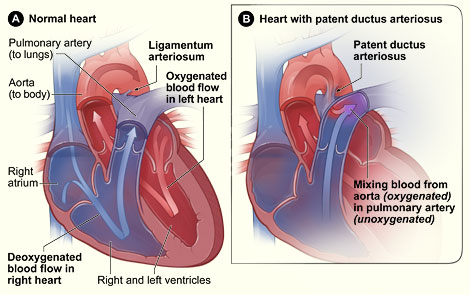What Is Patent Ductus Arteriosus?
Patent ductus arteriosus (PDA) is a heart problem
that occurs soon after birth in some babies. In PDA, there is an abnormal
circulation of blood between two of the major arteries near the heart. Before
birth, the two major arteries—the aorta and the pulmonary artery—are
normally connected by a blood vessel called the ductus arteriosus, which is an
essential part of the fetal circulation. After birth, the vessel is supposed to
close within a few days as part of the normal changes occurring in the baby's
circulation. In some babies, however, the ductus arteriosus remains open
(patent). This opening allows blood to flow directly from the aorta into the
pulmonary artery, which can put a strain on the heart and increase the blood
pressure in the lung arteries.

Figure A shows the normal anatomy
and blood flow of the interior of the heart. Figure B shows a heart with a
patent ductus arteriosus. The defect connects the aorta with the pulmonary
artery, allowing oxygen-rich blood from the aorta to mix with oxygen-poor blood
in the pulmonary artery.
A PDA is a type of
congenital
heart defect. A congenital heart defect is any type of heart problem that
is present at birth.
If your baby has a PDA, but has an otherwise normal
heart, the PDA may shrink and go away completely, or it may need to be treated
to close it. But, if your baby is born with certain types of heart defects that
decrease blood flow from the heart to the lungs or the body, medicine may be
given to keep the ductus arteriosus open to maintain blood flow and oxygen
levels until corrective surgery for the heart defect(s) can be performed.
About 3,000 infants are diagnosed with PDA each year
in the United States. It is more common in premature infants (babies born too
early) but does occur in full-term infants. Premature babies with PDA are more
vulnerable to its effects. PDA is twice as common in girls as in boys.
The next section, How
the Heart Works, provides a more detailed description of a heart with a PDA
compared to a normal heart. See that section for a more detailed description of
the anatomy and circulation of a normal heart.
December 2007
|

